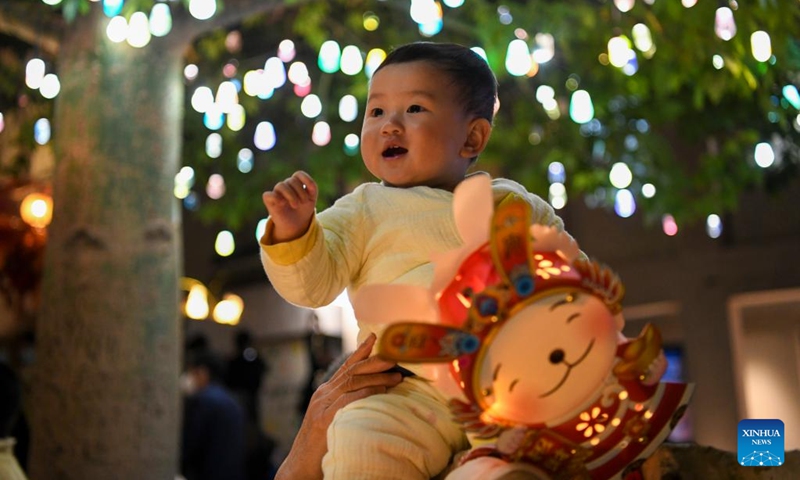
A kid is pictured at a Lantern Festival fair held in Nantou ancient town in Shenzhen, south China's Guangdong Province, on Feb. 4, 2023. A fair was held in Nantou ancient town to celebrate the upcoming Lantern Festival, which falls on Feb. 5 this year. (Xinhua/Liang Xu)
As people in China went out to enjoy various activities and the full moon high up in the night sky on Sunday, their enthusiasm for celebrating the Lantern Festival, also known as the Yuanxiao Festival, helped mark the end of the Spring Festival holiday.
The lantern festival falls on the 15th day of the first month of the Chinese calendar, which means it fell on a Sunday this year. Guessing lantern riddles, watching lantern parades and eating glutinous rice balls were some of the most common means to celebrate the traditional festival across the country.
An important part of the Spring Festival, the Lantern Festival has much more meaning than family reunion, more importantly it is regarded as a carnival of sorts for people to welcome the arrival of spring.
Over the past week, the search for keywords such as "lantern festival" and "lantern exhibitions" on Chinese travel ticketing platforms such as Ctrip, Meituan, Mafengwo, and Fliggy saw a sharp increase. The number of related searches on Ctrip has doubled compared with the same period in 2022 as the economy has been trending toward recovery across the country this year.
In addition, to keep up with demand from tourists as they flocked to the public venues to celebrate the day, countless public venues across the country opened night tours to bring lantern exhibitions and fireworks shows to crowds.
In Central China's Hubei Province, the Hubei Provincial Museum launched its first night tour on Sunday evening. Visitors could not only look at lanterns under the moonlight, but also appreciate a music concert performed using a bianzhong, a set of musical bells used to play music in ancient times.
In Shanghai, the centuries-old Yu Garden is famous for its exquisite layout, beautiful scenery and annual lantern exhibitions. As 2023 is the Year of the Rabbit, the Yu Garden has introduced a traditional Chinese myth exhibition based on The Classic of Mountains and Seas that combines ancient lantern art and AR technology to bring exhibits to people's mobile phones.
In addition to lantern exhibitions, over in Hangzhou, East China's Zhejiang Province, the Hangzhou Fireworks Show returned on Sunday evening after an 11-year hiatus to celebrate the festival and the 2022 Asian Games, which were delayed to September of this year.
People were full of undisguised anticipation for this visual feast on the night of the Lantern Festival: "The river-view rooms on the night [of the Lantern Festival] were booked long ago," a home-stay owner told the Global Times, "Many people have asked for rooms with the best angle to watch the fireworks, but clearly we can't guarantee that since we don't exactly where they're going to be set off."
The custom of lighting lanterns during the festival began in the Han Dynasty (206BC-AD220). During the Tang Dynasty (618-907), lantern appreciation activities became more extravagant as they were hung everywhere in the palace and on the streets.
In areas where traditions are well protected, local customs have been passed down for generations.
For example, at a fish lantern exhibition in Wangmantian village, Huizhou, East Chinas' Anhui Province, young people walk through alleyways holding fish lanterns as the sound of nearby firecrackers echoes of the walls.
"Through the courtesy of the fast communication across social media, many customs, including the fish lantern exhibition, have become much talked about topics online as the people who have enjoyed them post about them. While the festival atmosphere has reached its peak, it is also an excellent inheritance of folk customs," Deng Xiaoxiao, a cultural custom expert told the Global Times on Sunday.




